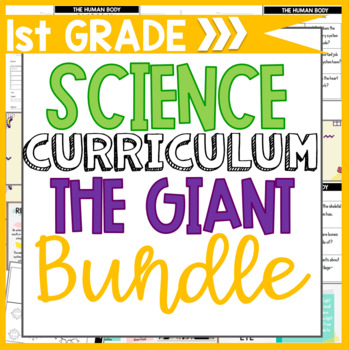1st Grade Science Curriculum
- Zip
What educators are saying
Description
SAVE 40% when you buy the bundle!
Wow! 9 units over 150 pages all brought together in 1 bundle to create an entire year of Science for 1st grade! Hands on fun included in every pack.
**UPDATED 8/2021**
Lots of additions to make this unit complete! I have added Unit 5: Space. This bonus unit includes a student book, interactive notebook pieces, posters, and a science station or center. I have added PowerPoints to several units here and updates the clipart and fonts. Enjoy!
Topics Include:
BEST SELLER- Fun, hands-on Science is LOADED in this packet! If you are looking for thinking maps, lesson plans, science stations, and foldables for Science interactive notebooks, this is what you are looking for! All with the objective of Force and Motion.
Another TOP SELLER- Complete natural resource unit! Anchor charts with pictures and definitions, thinking maps, folables, interactive notebook pieces, and a mini reader!
This "What is a Scientist" pack includes 5 different interactive activities for the primary grades.
Living and nonliving unit FULL of foldables and interactive notebook pieces. This set has numerous interactive pieces as well as diagrams with cut and paste pieces, plants, animals, and everything in between. Perfect for a unit on living and nonliving!
This hands-on unit includes multiple pieces for science notebooks, experiments, thinking maps, and foldables all focusing on the properties of MATTER!
This inquiry skills unit will be a great addition to any Science curriculum! It includes several activities that students can use their inquiry skills, anchor charts, and an interactive emergent reader. Students will be comparing, estimating, measuring, sorting, classifying and more!
This unit focuses on types of clouds! If you are looking for a little bit of everything to teach your students about clouds, this is the perfect pack!
This is 29 pages packed FULL of activities for animal groups! Mammals, reptiles, amphibians, birds, and fish are covered in this unit with posters, anchor charts, foldables, thinking maps, science notebook pieces, and 5 mini books.
This unit focuses on fast and slow changes to Earth. In this pack you will find foldables, hands on activities, posters, and more! All activities are centered around the fast and slow changes to Earth. Topics include volcanoes, earthquakes, erosion, wind, and water.
In each packet you will find interactive activities, PowerPoints, foldables, experiments, mini books, and LOADED with Science fun!



